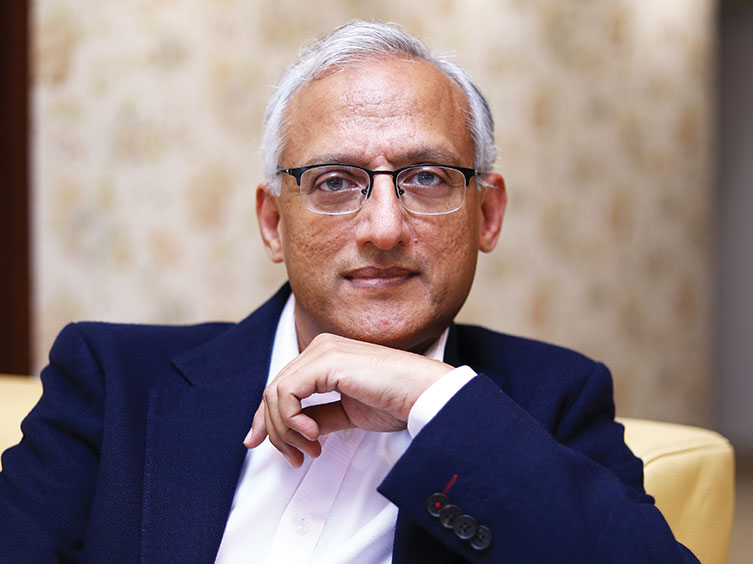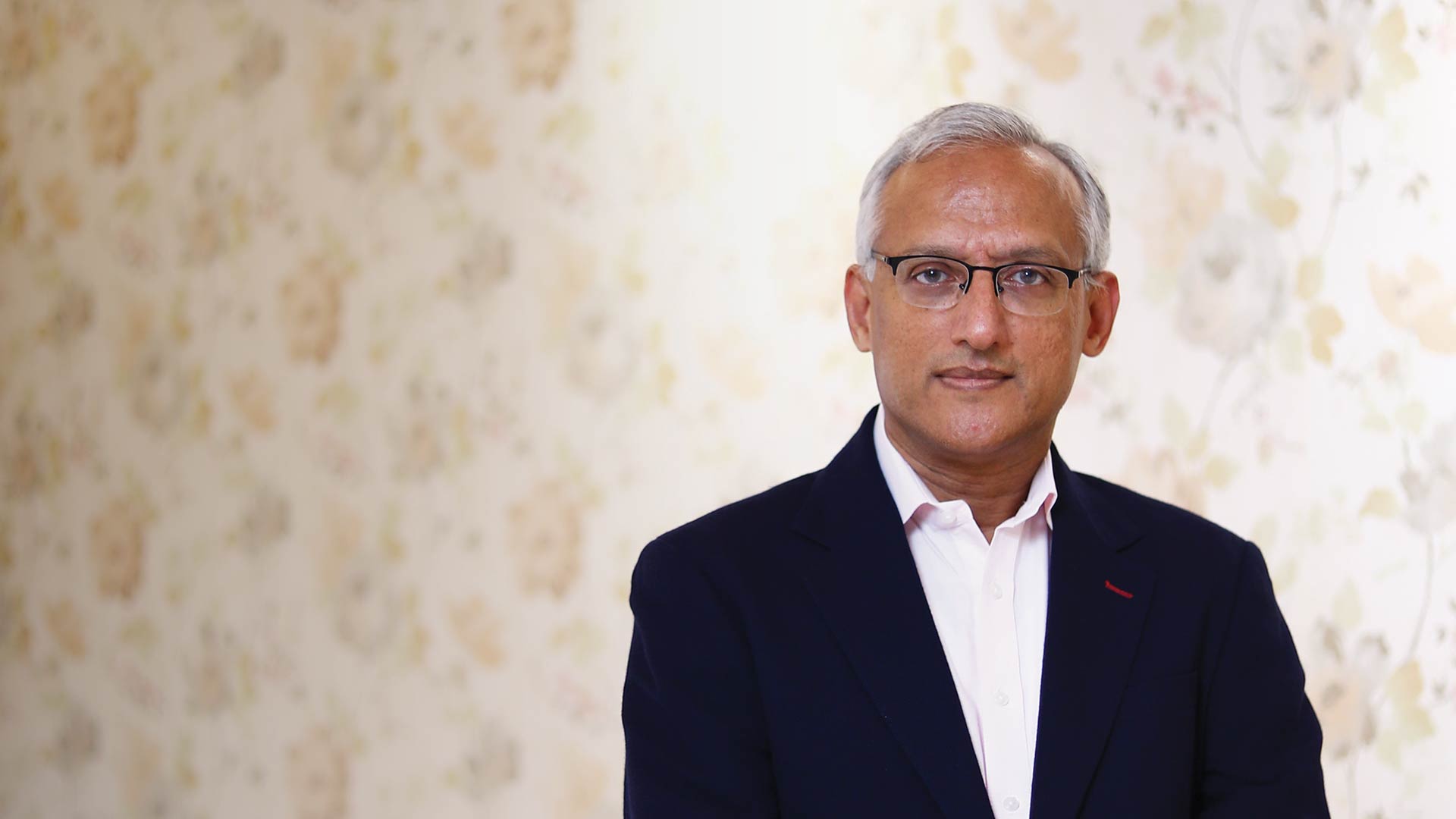January 2021 | 1969 words | 7-minute read
In a career spanning 35 years, Amur S Lakshminarayanan has executed a range of leadership roles across industries and geographies, making him uniquely equipped to take on his most notable and challenging endeavour yet — CEO & MD of Tata Communications.
Before the global digital ecosystem enabler announced his appointment in October 2019, Lakshmi (as colleagues and friends prefer to call him) was the CEO of Tata Consultancy Services (TCS) in Japan, where the company had a joint venture with Mitsubishi Corporation. The five-year stint was a tremendous experience in a new geography with a local giant.
Prior to that, his time at TCS was spent in the UK, where he started as the country manager for the company in 1999, overseeing some of the largest deals and expansions into new markets — a journey he describes as exhilarating. He was later responsible for both the US and European markets until 2011, when he took on a global role as a business group head for TCS for multiple industries, telecom being one of them. Excerpts from an interview:
Looking back on your first year as CEO and MD of Tata Communications, how did your experiences and learnings at TCS help you adapt and thrive in your new role?
While I had dealt with telecommunications companies who were TCS’ customers, working from inside a telco and managing it is an altogether different ball game.
However, my strength has always been in areas related to understanding enterprises/customers, evaluating what our proposition should be, and figuring out how we should go about executing the said proposition for our customers. That’s the kind of knowledge — and some of the rigour of planning and execution — that I bring to the table. For me, the first year has been about ramped up learning, in terms of what Tata Communications is about, what our customers want from us and the products we have.
"Our strategy called for us to move from being product-oriented to platform-oriented.”
Did you have certain set goals for this first year, and how far would you say that has been achieved?
There weren’t any pre-decided goals for year one, or any such, but obviously, I did have interim milestones in mind. When I joined in October, I gave myself three to six months to understand the company. But very quickly, I realised — as did the management team — that there were many things we could do starting immediately, even before we formally rolled out our new business strategy in March 2020
This included getting our operating model better aligned to what our customers wanted so that they can be agile and competitive, and ensuring we are at the right cost space structurally. We started executing from November 2019 and are proud of how quickly that has been reflecting in our numbers.
Our strategy called for us to move from being product-oriented to platform-oriented. A major shift that we’ve made in 2020 is to understand the customer context better and stitch together our products to deliver a customised solution to them.
It’s still early stages, but we’ve had one or two successes; we’re confident we will be able to replicate them.
Through your conversations with customers, what insights did you gain about what they needed in order to bring about digital transformation in their organisations?
Through my interactions with customers, five large themes emerged regarding customers’ expectations from digital.
Firstly, digital, which was previously seen as a disruption, is now being increasingly adopted by companies to accelerate growth — what we call, borderless growth. Our customers worldwide sought to seamlessly grow across regions and build ‘anywhere’ operations, while accessing the markets using digital.
Secondly, they were seeking ways in which digital can help product and service innovation. Third, they wanted to use digital to deliver more productivity and efficiencies within the organisation. For example, if you look at international customers, they have to deal with multiple providers. We give them a one-stop shop. If they have to meet on Microsoft Teams, for instance, they require the network, SIP trunking and calling plans. We are able to offer them that, across the world, on a single contract with a very high service level agreement. That simplification ensures efficiency.

The fourth question was, how do we build agility in what we do? Digital without agility is not very meaningful. In our context, when customers were moving to the Cloud, our task was to make the underlying network more agile to enable our customers to connect anywhere.
The last theme pertains to managing risks. As people move to the Cloud, the security vectors become more complex. As a network and Cloud provider, how do we deliver security seamlessly to the customer, while providing futureproofing?
These five themes stood out, and our solutions aim to address each of them.
How does the Secure Connected Digital Experience (SCDx) solution meet your customers’ expectations?
SCDx is an overall proposition. It is an example of how we’re shifting away from just a product conversation, to solving the customers’ problems by stitching together multiple products.
For instance, one of the customer requirements, as I mentioned, was using digital for product and service innovation. One of our retail customers wanted to transform how they’re taking the store to home — an innovation in terms of how they are selling to their customers. Essentially, while browsing the retail website, how can the customer make a call to the store to see a demo of a refrigerator or a car?
Next, if the store wants to give a demonstration to the consumer, and the consumer says they want to invite their parent or friend on that call to help them make a purchasing decision, how do we enable video collaboration from the store?
We’re making all of this possible. We stitched together our InstaCC platform to be able to deliver video calls and route them. We then inserted video, messaging and networking capabilities to deliver this complete solution. When this solution becomes repeatable, it becomes a platform.
Before the pandemic, we had a slightly slimmed down version of this solution. We had delivered it to the State Bank of India to enable them sell some of their products to high net worth individuals. With the pandemic, the solution needed to be expanded.
Within SCDx, we have three broad portfolios. One is enabling anywhere operations. For example, we have enabled TCS, when they had to shift their employees to working from home, using some of our traditional solutions. Then we have our offerings on secure connectivity. Plus, there is NetFoundry, a zero-trust based option, bringing about 5x to 10x speed in connectivity to applications.
The second portfolio is our customer experience platform. People have previously used WhatsApp and Google for this, but what we’re offering is industrial strength. The store or the financial advisors’ conversations are encrypted; it’s secure and regulatorily compliant.
The third portfolio is B2B. How do we develop an ecosystem for large customers if they have a large supply base to communicate with? How can some of our solutions be stitched together to deliver a seamless, secure and connected experience to those customers?
How did Covid-19 impact your business plans for the year, and what fresh opportunities did the pandemic present?
Like all companies, we’d prepared a business plan in February-March. We had to alter some plans, largely around capex investments, given the uncertain times ahead.
Business was also impacted in terms of customer segments like travel and hospitality, which came to a complete standstill; we support quite a few sporting events around the world, which were cancelled this year.
However, we were agile in seizing opportunities. In a short span, we delivered 650+ orders across the globe, providing new connectivity, fulfilling data centre requirements and expanding existing bandwidth for all Cloud providers, as Cloud usage grew exponentially during this time. The SCDx proposition was also prepared and accelerated during Covid.
We also had a proposition for media. We bring live sporting events to fans across the world. For example, for the Indian Premier League (IPL), the television network typically would have to send people to Dubai and manage production. But now, production is increasingly happening remotely. We’ve launched remote production, whereby editors can edit a live match sitting at home. We’re doing this for several other global sporting federations such as MotoGP, European Tour, and so on.
Many organisations have said they’re prepared to have employees working from home in the post-Covid world. How do you envision the change to remote working?
I don’t think we will go back to working the way we did before the pandemic. Nor will it be the way it is currently, because face-to-face interactions for certain activities is a must, both internally as well as with customers. It will bounce back to an equilibrium point for the long term, but we don’t yet know what that point will be.
"We were agile in seizing opportunities. In a short span, we delivered 650+ orders across the globe, providing new connectivity, fulfilling data centre requirements and expanding existing bandwidth for all Cloud providers, as Cloud usage grew exponentially during this time."
It will also differ for different industries. For the knowledge industry, 80 percent may continue to work from home. For an organisation like ours that has wires running and assets to manage, it might be a shift from the current 96 percent to 60 percent working remotely.
In the meantime, the focus has been on employee wellness and engagement. Working from home can be a boon for some and stressful for others. We’ve rolled out many wellness programmes and are piloting others to enable employees with better tools so that working from home isn’t drudgery, but a pleasure.
In terms of engagement, the challenge is we’re onboarding employees while working remotely. I haven’t met our new CFO face-to-face yet, for instance! While it is easier at our level because we communicate on an everyday basis, we have to think about how to build a sense of belonging for employees who have not met any of their colleagues and may not interact with most of them regularly. That is something our HR and business teams are constantly working on.
Tata Communications is a global enterprise. How significant is the India market in this mix?
We recognise India as a major market; we have a good market share with enterprises in this space, so our focus is how to expand it and serve customers better.
Having said that, the international market is very significant for us. Today, our revenue split in the international and India market is roughly 60:40, or close to 50:50, depending on how we classify some of the international accounts. But international has a much bigger whitespace. For example, from a network perspective, India is a $1.5 billion market, while internationally, it’s $145 billion. In the international markets, we are a challenger, so there is more upside. In India, we are a market leader, and we want to be able to maintain and expand market share.
Lastly, with your vast experience in leadership roles, what qualities according to you are a must for a leader?
I think it’s important to be able to set a vision, show your team what is possible and instil confidence in them to be able to achieve it.
Secondly, the ability to mobilise the entire company and get them to believe in your strategy. Everybody has to be on the same page. Only then can execution be aligned.
Next, there has to be execution rigour. Part of that is how do we improve the metabolic rate of the company — the rhythm we operate at and the output we deliver. That is important for a leader to determine.
And finally, one of the qualities required of leadership is to be able to spot and nurture talent.
—Anuradha Anupkumar













